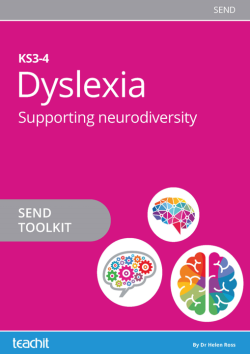Dyslexia toolkit
Dyslexia toolkit aims to help subject teachers, form tutors and teaching assistants to support dyslexic students in the mainstream classroom at key stage 3 and key stage 4. Whatever your role in supporting students with dyslexia, this toolkit will give you understanding, tangible ideas and practical strategies to enable young people to realise their full potential.
Looking to support children in key stages 1 and 2? Try our Dyslexia toolkit for primary.
Note: Dyslexia toolkit is a digital download, but it is part of our SEND collection and is not included in a Premium subscription.
What’s included?
This 56-page downloadable toolkit includes:
- information about neurodiversity, the strengths of neurodivergent people and some of the challenges they face
- information about dyslexia and how to identify it in the classroom
- a CPD PowerPoint for staff training, parents’ evenings and senior leadership meetings
- advice on avoiding sensory overload
- games to develop learners’ short-term and working memory
- templates for sentence starters, task maps and writing planners to reduce the load on learners’ working memory
- guidance on chunking tasks into manageable steps to help students to process information
- dyslexia strategies for reading
- writing strategies for students with dyslexia
- information about the link between a weak working memory and spelling difficulties, plus dyslexia spelling strategies
- strategies for supporting students with dyslexia in the maths classroom
- top tips on harnessing dyslexic strengths such as empathy and problem solving
How does it support dyslexic students?
Dyslexia toolkit offers dyslexia-friendly strategies that can be used with the whole class so that neurodivergent learners are not put on the spot. There are also approaches that can be carried out in small groups, and suggestions for how dyslexic students can support their classmates, fostering a supportive learning environment and helping young people to feel empowered. Information and activities are provided to raise awareness of what it feels like to have dyslexia, and ways are suggested of playing to dyslexic learners’ strengths.
The toolkit includes tick lists for learners to articulate their own areas of challenge and learning preferences, and it provides printable resources to help students to plan written tasks. There is also a step-by-step guide for students to reading for comprehension and an overview of pros and cons of assistive technology such as electronic readers.
About the writer
Dyslexia toolkit was written by Dr Helen Ross, a leading voice on dyslexia within UK education. She is an experienced public speaker, international consultant and researcher, and contributor to a wide range of publications; Helen is also dyslexic.
She supports families, teachers and organisations to better understand the implications of dyslexia, neurodiversity and special educational needs and disabilities (SEND).
In this toolkit, Helen draws on her experiences as a classroom teacher, SENDCo and dyslexia expert to help you to understand what dyslexia is, which aspects of learning can be affected by dyslexia and what you can do to support dyslexic learners.
What's inside?
- Introduction
- What is neurodiversity?
- What is dyslexia?
- Case studies
- Classroom strategies
- Memory and verbal processing support
- Classroom strategies and activity ideas
- Printable resources
- Reading support
- Classroom strategies and activity ideas
- Printable resources
- Assistive technology
- Writing support
- Printable resources
- Spelling support
- Classroom strategies and activity ideas
- Printable resources
- Maths support
- Classroom strategies and activity ideas
- Printable resources
- Dyslexic strengths
- Classroom strategies
- Further information
- Glossary
- Useful links
- References
This toolkit is part of our ‘Supporting neurodiversity’ series – a new collection for teaching neurodiverse students and supporting young people with specific learning difficulties (SpLD). Our other neurodiversity toolkits include:
If you teach at a primary school, see Dyslexia toolkit (Primary).
For resources to support students with Tourette Syndrome, see the resource collection from our partner Tourettes Action.
You might also like Helen's article on Integrating dyslexia support into mainstream teaching.
Note: Dyslexia toolkit is a digital download, but it is part of our SEND collection and is not included in a Premium subscription.
An extract from the 'What is dyslexia?' section:
Dyslexia can be the root cause of students’ challenges in reading, writing and spelling, and in accessing other areas of the curriculum. It is a complex, often contested phenomenon, with some researchers and practitioners debating its very existence (Elliott and Grigorenko, 2014), due to some definitions not fully clarifying how dyslexia differs from other challenges students have in literacy development.
Dyslexia is understood as a specific learning difficulty, whereby ‘an individual has difficulties or weaknesses in just one or two areas in contrast to average or good cognitive skills’ (Helen Arkell Dyslexia Charity, 2022), and is not limited to any specific demographic, linguistic or academic background. It is important to note that there are several definitions of dyslexia within a UK policy context, which can mean that formal identification must be done with careful reference to an appropriately clear set of criteria. The British Dyslexia Association (BDA) bases its definition of dyslexia on the definition put forward within the Rose Report (2009), with the additional detail of associated challenges commonly linked to dyslexia and other specific learning difficulties ...

